Sinus lifting and simultaneous implantation

Dear friends, in previous articles, we discussed with you what kind of wisdom teeth are and how the removal of these very teeth goes . Today I would like to digress a little and talk about implantation, and in particular simultaneous implantation - when the implant is installed directly into the hole of the extracted tooth and about sinus lifting, - an increase in bone tissue height. This is required when installing implants in the area of 6th, 7th, less often 5th teeth on the upper jaw. Bone buildup is required because there is a cavity in the upper jaw - Maxillary sinus. Most often, it occupies a large part of the upper jaw, and the distance from the edge of the bone to the bottom of this sinus is not enough to install the implant of the desired length.

')
On computed tomography clearly shows that there is a failure in the area of the missing tooth.
Often I hear doctors say, “No, no, no, you cannot immediately put an implant!” First we remove the tooth, and how everything will heal, then we will install it! ” A reasonable question - why? But who knows. Most interesting. Whether because of uncertainty in the forecasts, or because of fear of complications, which, in fact, no more than with the classical operation. Of course, with the condition that everything is done correctly. In my practice, the percentage of simultaneous implantation with respect to the classical approach is about 85% to 15%. Agree, not a little. Where practically every operation in which a tooth extraction is indicated ends with implantation. The only exception may be acute inflammation in the region of the causative tooth, when pus mixed with snot is flowing. Or, when the implant is not at all stable and hangs in the hole, like a pencil in a glass. Financial opportunities also play an important role. Anyone spends money with more hunting for anything, but not for teeth. With this you can not argue. But there is one "But"! You should understand that the more time passes from the moment of tooth extraction to the start of prosthetics, the worse the conditions for the placement of this implant. As the saying goes: - "A holy place is never empty." Over time, there are a number of the wildest problems that also have to be solved. And these are always additional, and often considerable, expenses. Do you need it?
Well! Let us turn to examples.
The simplest case of simultaneous implantation is a single-root tooth. Be it the upper or lower jaw.
This CT scan was done before the tooth completely collapsed.
What do we see?
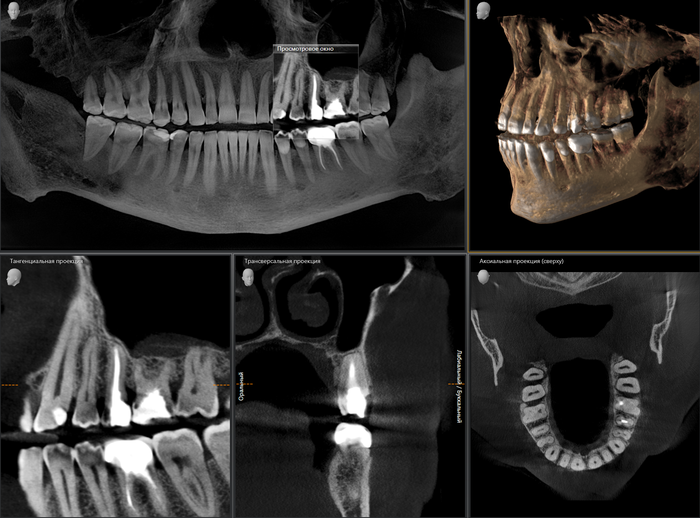
Upper left 5-ka, not subject to any therapeutic or orthopedic treatment. What are we doing? That's right - we remove the tooth and screw in the bolt.
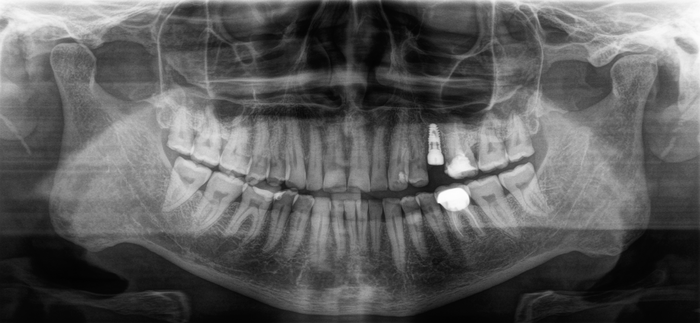
I performed the most gentle, atraumatic tooth extraction and installed the implant with a gum former.
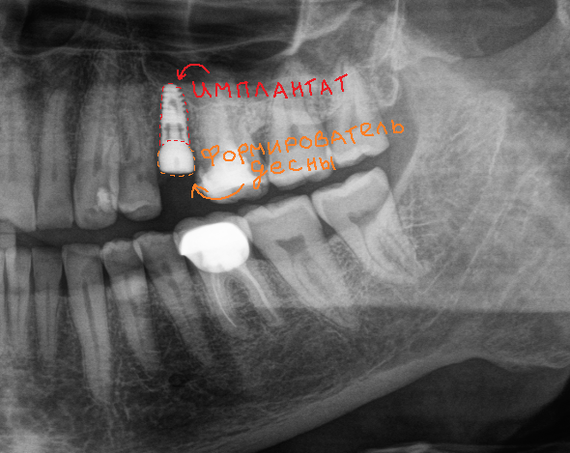
The gum former is something like a low (average 3mm. In height) metal hemp that sticks slightly above the gum level, thereby forming its contour before installing the crown. It looks like this:

And this is what the implant itself looks like:
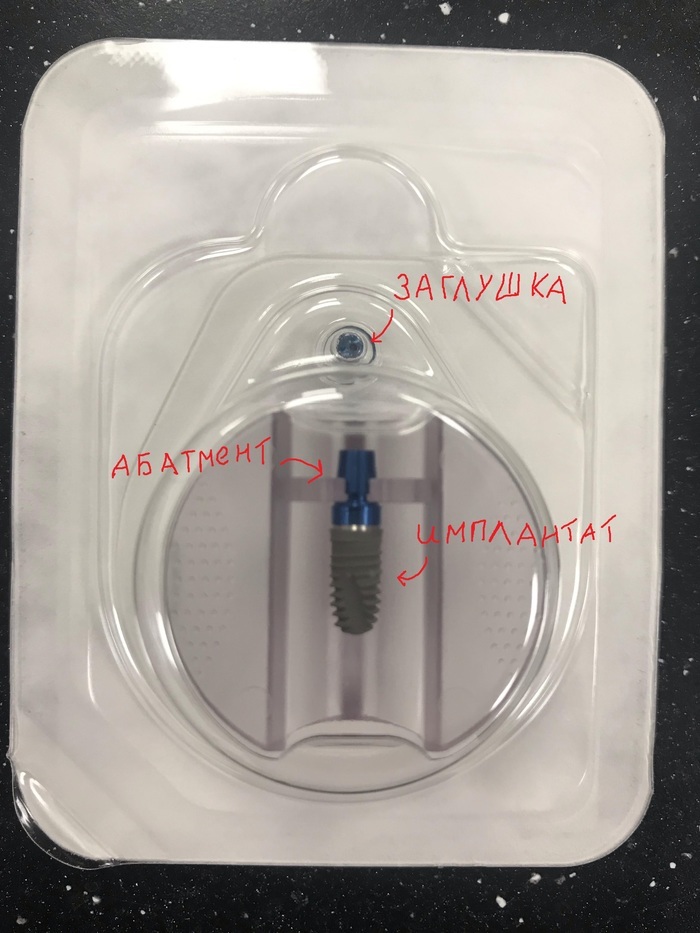
The gray part is the implant itself. The blue part is the so-called temporary abutment, on which a temporary crown can be fixed, if the implantation is accompanied by an immediate load. Basically, this abutment acts as an implant holder. After the implant is installed, the abutment is unscrewed, like a designer, with a special screwdriver, and a plug is screwed into its place. It is installed in the event that it is impossible to immediately install the gum former. Then the implant and all its constituent parts are completely under the gumline, which means that we will not see anything in the oral cavity after the operation. Well, except for the seams and ... the rest of the teeth, if they still remain. In this situation, the shaper is installed after the implant has taken root.
Next, select the next level of difficulty when you have to remove the 6th tooth on the lower jaw. This tooth is a two root. We, of course, will not install an implant into the area of each root, as someone might have thought. Although I have seen similar cases. At the doctor, probably, the credit on a mortgage burned.
So, we need to install one implant, but clearly in the center. We will aim at the bone septum between the two roots.

Install the implant. To the left and to the right of it, in the picture, the holes from the newly extracted tooth are clearly visible, which, as the healing proceeds, will tighten.
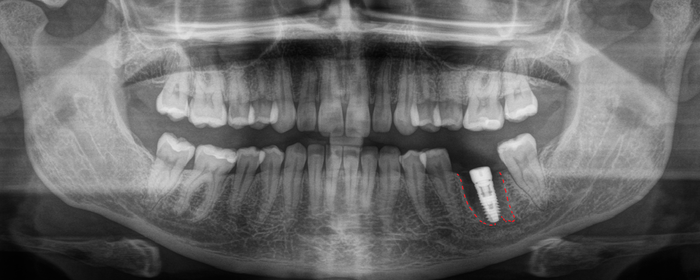
Well, it's time to consider the case when you need to remove a tooth, install an implant and hold bone buildup on the upper jaw - sinus lift. And the level of complexity, meanwhile, is increasing. Not a mission with helicopters from Vice City, of course, but you have to be a little more attentive than in the previous case.
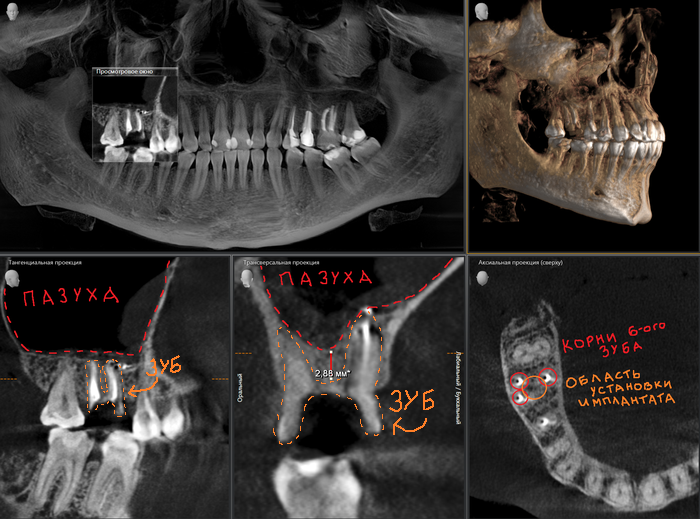
Remember, I said that the implant should be centered? So the 3-root tooth is no exception. The implant is installed, as in the previous case, into the septum, but already of a three-root tooth. As we can see the height of the bone in this area is about 3mm. This volume is not enough for setting the implant of optimal length, therefore the volume needs to be increased. The manipulation is carried out with the help of a special "bone material". Someone calls it "bone powder", not to be confused with "white powder", although it is white, but presented all the same in the form of granules. Produced as simple in glass containers
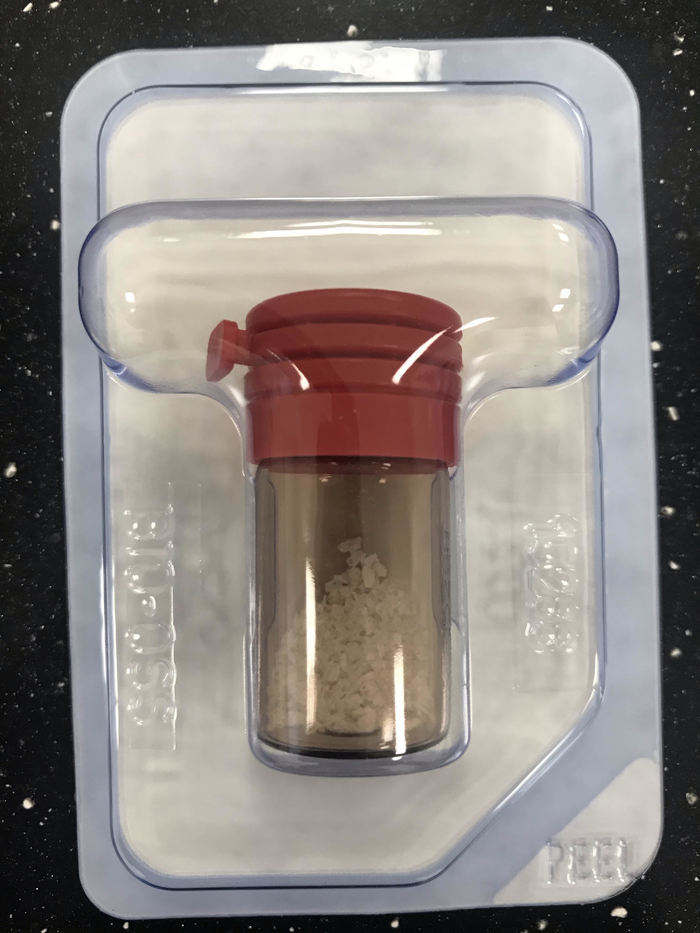
and in a more convenient form - special syringes, with the help of which it is more convenient to work and bring the material into the surgical field.
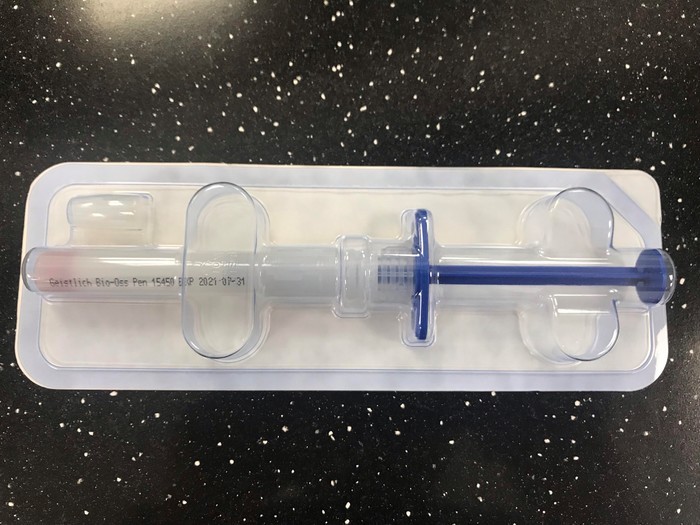
It is a mistake to believe that a sinus lift is an operation “B” of the maxillary (Maxillary) sinus. In fact, the manipulation is carried out "under" it. As we have already found out, the sinus is a cavity in the upper jaw, an emptiness, if you like, which is lined from the inside with a thin mucous membrane with ciliated epithelium. So, in order for the operation to take place, locally carried out the detachment of the mucous membrane from the bone tissue and in the formed space between the bottom of the sinus and the mucous membrane, as in an envelope, “bone material” is placed. In this case, with the parallel installation of the implant.

And now an example of sinus lifting and implantation, but 2 months after the 6th tooth was removed in the upper jaw. This patient was removed 6-ku about a week ago at another clinic. Assistant made computed tomography.

Due to the fact that after the removal only a week has passed, we see a “dark hole” in the picture, like the one that the former left in your heart. In the place where there used to be a tooth. That is, there is no bone tissue in this area. I started the operation in 2 months. Repeated computed tomography after the healing of the wells did not, but believe me all healed enough so that you can perform the operation. It was not possible to achieve tight stabilization of the implant during the operation, so I decided to install the plug, but not the gum former. Why? And because if the patient begins to gnaw crackers, then the implant, in particular the former, can be put under strong pressure, and therefore the implant can loosen or “fly” into the sinus. At the same time went to the scrap and 8-ka.
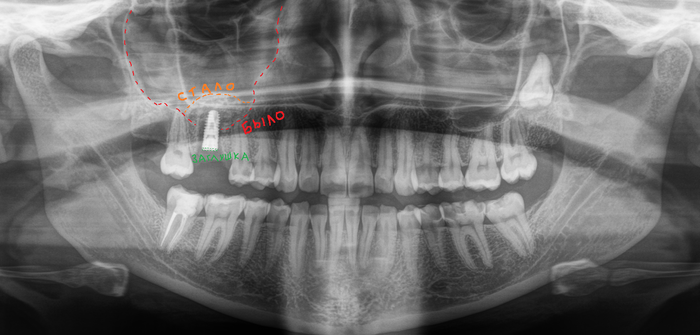
Well, the last example for today is the removal of 2 teeth, the installation of 2 implants and sinus lifting.
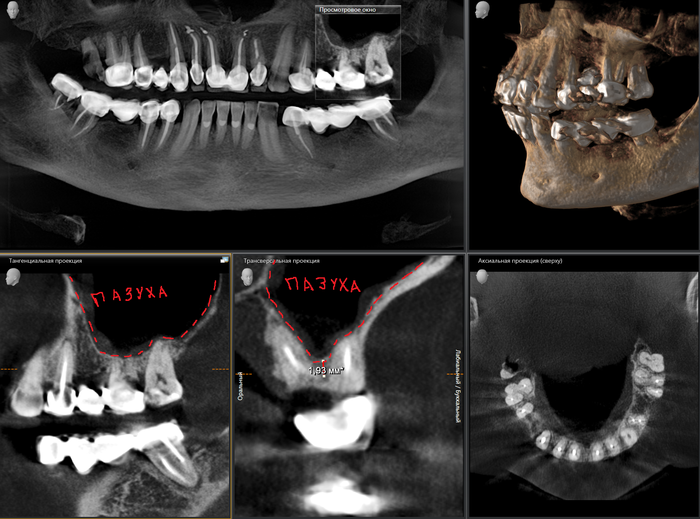
As we can see the conditions in this case are somewhat worse about 2mm. But this did not prevent us from carrying out the operation in full.
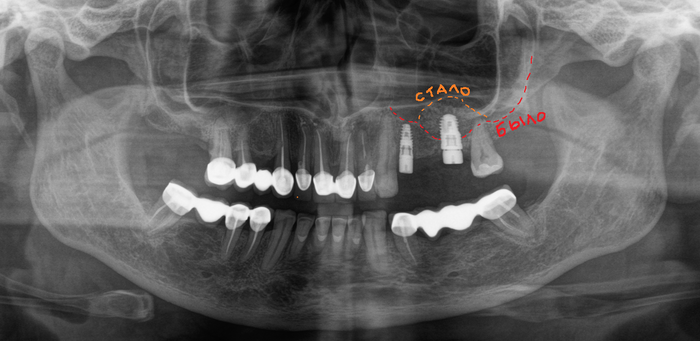
You may ask: - “Why are there 2 implants, not 3?” “What, will there be a bridge prosthesis?” “But what about the load distribution,” etc.?
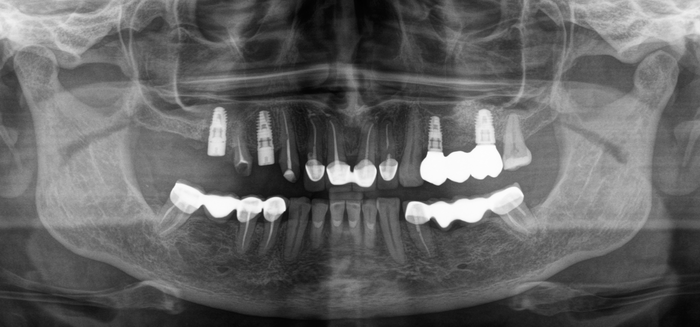
In fact, the problem of overloads associated with bridges, relate only to their teeth. Since the teeth have a ligament apparatus. That is, the tooth is not tightly adhered to the bone, but, as it were, spring in it. Here is the diagram:

If there is a bridge, the abutment teeth assume both their own load and the load of the tooth that is missing. Thereby, an overload of the teeth develops, and then they end up at the tooth fairy. The implant does not have such a ligament. It merges tightly with the surrounding tissues, so there are no similar problems, as is the case with their teeth. But this does not mean that you can install a huge bridge over the entire jaw with two implants. The only thing that suffers in the presence of bridges is hygiene, it will need to be monitored very carefully. Because how to care for separately standing teeth is much easier than for such dentures.

That's all for today. I will be glad to answer your questions!
Stay tuned!
Sincerely, Andrei Dashkov.
Source: https://habr.com/ru/post/455852/
All Articles